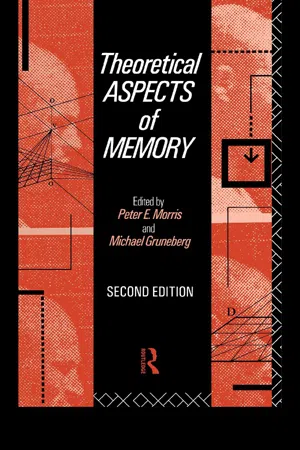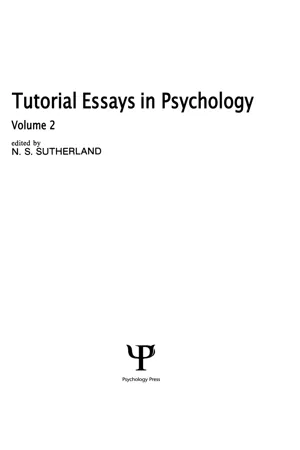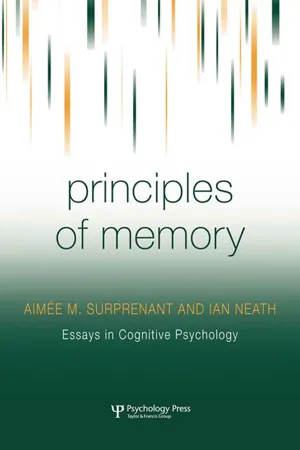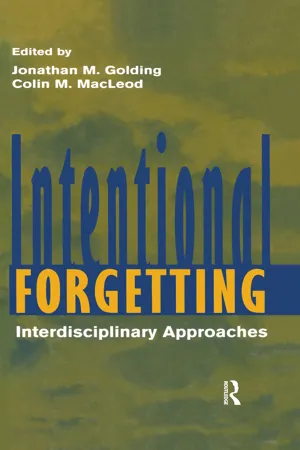Cue-Dependent Forgetting
Cue-dependent forgetting is a phenomenon in memory where the ability to recall information is influenced by the presence or absence of specific cues or prompts. When the retrieval cues present during learning are not available during recall, it can lead to difficulty in remembering the information. This concept highlights the importance of environmental and contextual cues in memory retrieval.
6 Key excerpts on "Cue-Dependent Forgetting"
- eBook - ePub
Theoretical Aspects of Memory
Volume 2
- Michael Gruneberg, Peter E Morris, Michael Gruneberg, Peter E Morris(Authors)
- 2006(Publication Date)
- Routledge(Publisher)
...For example, in a depressed mood, a subject might learn and remember negatively valenced words, such as ‘funeral’ or ‘sorrow’, better than positively valenced words, such as ‘funny’ or ‘carnival’. Although mood congruent effects resemble mooddependent memory effects, they are not the same. Mooddependence is a principle that relates study and test moods to each other, whereas mood congruence describes a relation between subjective moods and target stimuli. THEORETICAL PRINCIPLES A number of basic principles can be induced from the empirical studies reviewed above. Although these principles are intended to explain contextual dependence, they do not necessarily imply specific theoretical mechanisms. Principles such as cue overload, outshining or decontextualization can be implemented with different theoretical mechanisms in different theories. Any memory theory, however, that involves context-dependent memory should incorporate these basic principles. The principles to be considered here will include cuedependence, overshadowing, contextual fluctuation, cue overload, memory probe, outshining and decontextualization. Cue-dependent memory The principle of cue-dependent memory is simply that performance on memory tasks is influenced by associated memory cues. If contextual information is associated with target material, then contextual cues should stimulate memory for associated material. There are many theoretical mechanisms that can explain context-dependent memory, and a few will be described here. These include activation of a set of information in memory, direct context-to-item associations, mediation by internal states, and activation of cognitive operations. Activation of a search set Shiffrin (1970) described retrieval as a probabilistic iterative process involving sampling-with-replacement from a delimited set of information in memory. The delimited set was referred to as a ‘search set’, or the set of information in memory that was to be deliberately searched...
- eBook - ePub
- Alan Baddeley, Michael W. Eysenck, Michael C. Anderson(Authors)
- 2020(Publication Date)
- Routledge(Publisher)
...One can also distinguish cognitive context, which can mean particular collection of concepts and ideas that one has thought about in the temporal vicinity of the event. In our later section on context-dependent memory, we will discuss how all of these types of context can constrain what we retrieve of our past, even when we are not aware of it. Context cues also play a role in defining the types of retrieval tasks often used to study memory. Retrieval tasks Each day, life leaves its bootprints in our mental clay, and these imprints influence us in many ways. Sometimes, we are deliberate users of memory, trying to consciously recollect what happened in times past. Other times, we may not intend to be influenced by memory, but are, without being aware of it. Psychologists have devised numerous methods for testing retrieval that get at these circumstances. These tests reflect various circumstances in daily life, and differences in memory across test types have taught us important lessons about the structures and processes of memory. Direct memory tests Tests that ask people to retrieve their past are known as direct/explicit memory tests (Richardson-Klavehn & Bjork, 1988; Schacter, 1987). Because they ask people to intentionally recall particular experiences, these tests require a representation of temporal context as a cue and also the adoption of an explicit retrieval mode (i.e., a mental set in which people intend to treat stimuli as cues to search memory). Direct tests vary in the amount of cues given, the amount to be retrieved, and in the involvement of retrieval strategies. Free recall relies on context the most heavily because people must retrieve an entire set of studied items without overt cues, freely—that is, any order. For example, if you studied 25 words and then tried to recall them in any order, you would be performing free recall. Free recall mimics situations in daily life in which we must produce a lot of information in no particular order...
- eBook - ePub
Tutorial Essays in Psychology
Volume 2
- N. S. Sutherland, N. S. Sutherland(Authors)
- 2014(Publication Date)
- Psychology Press(Publisher)
...4 Analyzing Memory by Cuing: Intrinsic and Extrinsic Knowledge Gregory V. Jones University of Oxford This chapter is concerned with the processes which underlie the everyday use of human memory. One of the most striking aspects of memory is the richness of the interconnections between different items of stored information. Until quite recently, however, most experimental studies of human memory have investigated the recall of isolated pieces of information such as sets of unrelated words. It can be argued (Neisser, 1976) that one of the most pressing needs within experimental psychology as a whole is to investigate processes of a degree of complexity comparable to those that occur in everyday life, and several such studies have recently been reported (e.g., Linton, 1975; Robinson, 1976). It must be recognized, however, that in general the price of investigating more complex examples of recall is an increase in the difficulty of maintaining experimental control. For example, in an interesting study, Robinson (1976) presented subjects with cues such as "window," "run," or "happy," and asked each person to think of a specific incident of which the word reminded him or her. One of the findings was that affect terms such as "happy" induced recall of more recent events than did object or activity terms such as "window" or "run." One interpretation might be that memories of such incidents decay particularly rapidly, and thus only comparatively recent emotional experiences are available for recall. It could be, however, that people experience incidents relating to "happy" more frequently than those relating to "window" or "run," and hence come across such incidents earlier when scanning backwards in time. To decide between these two interpretations it would be necessary to undertake an experiment in which the frequency of occurrence of such incidents was controlled...
- eBook - ePub
- Aimée M. Surprenant, Ian Neath(Authors)
- 2013(Publication Date)
- Psychology Press(Publisher)
...Yet another account of similar data is offered by the feature model (Nairne, 1990), which also requires cues. Connectionist models of memory are also cue driven (cf. Ratcliff, 1992). Humphreys, Bain, and Pike (1989) present a model that specifies the cues used not only in episodic and semantic tasks, but also those that tap procedural memory. In fact, it is hard to conceive of a computer model of memory that is not cue dependent, simply because the computer requires something to start the retrieval process. 3.2 Memory Without Cues There is one area of memory research in which the opposite assumption is made, that is, memory does not require cues. For example, Kintsch, Healy, Hegarty, Pennington, and Salthouse (1999) summarized 10 different theoretical accounts of working memory, highlighting similarities and differences among the various conceptions. They explicitly noted that because of the common assumption that “information ‘in’ working memory is directly and effortlessly retrievable, … retrieval from ST-WM is not cue dependent” (pp. 413–414). 2 Similarly, Wickens, Moody, and Dow (1981, p. 17) state that “the retrieval act is not required in the PM [primary memory] situation.” More recently, Jonides et al. (2008, p. 202) note that “the central point of agreement” among current models of short-term memory is that “representations are directly accessible and available for cognitive action.” One particular version of working memory that posits cueless retrieval is called the embedded processes model (Cowan, 1995, Cowan, 1999). Essentially, memory is divided into three parts (see Figure 3.1): Long-term store, activated memory, and the focus of attention. Together, the activated part of long-term memory as well as the contents in the focus of attention comprise working memory. According to this view, an item becomes activated when it receives attention, and activated items can enter the focus of attention when they are the object of current processing...
- eBook - ePub
Intentional Forgetting
Interdisciplinary Approaches
- Jonathan M. Golding, Colin M. MacLeod, Jonathan M. Golding, Colin M. MacLeod(Authors)
- 2013(Publication Date)
- Psychology Press(Publisher)
...In both real-world situations and analogous research paradigms, cues to forget, although clear, are typically implicit. As we park our car in the morning, for example, we do not tend to instruct ourselves to forget the event of having parked our car in a different spot the preceding morning, nor do there tend to be signs posted that instruct us to do so. Similarly, in the various paradigms that incorporate an intrinsic updating requirement, such as the Brown–Peterson short-term-memory paradigm and the A–B, A–D list-learning paradigm of interference research, the cue to forget, although clear, is implicit. As each successive to-be-remembered set of items is presented in the Brown–Peterson paradigm, for example, the structure of the task itself makes it clear to subjects that the items from the preceding trial should now be forgotten, that continuing to remember them is a potential source of errors. In other research paradigms, such as the retrieval-induced-forgetting paradigm (Anderson, Bjork, & Bjork, 1994), there is also an implied cue to forget, but the cue, as defined by the task itself, is more subtle and differs qualitatively from the implied cue in updating paradigms such as the Brown-Peterson or A–B, A–D paradigms. In the retrieval-induced-forgetting paradigm, a study phase is followed by a retrieval-practice phase, during which subjects are cued to retrieve some of the studied items multiple times and then, after a delay, are asked to recall all the items from the study phase. Typically, the to-be-remembered items are category-exemplar pairs where multiple exemplars are paired with each of a small number of category labels during the study phase. During the retrieval-practice phase, when subjects are cued via a category name and a letter stem to retrieve the particular studied exemplar that fits that combined cue, there is an implied cue to suppress or inhibit other exemplars that were paired with that category during the study phase...
- eBook - ePub
The Structure of Long-term Memory
A Connectivity Model of Semantic Processing
- Wolfgang Klimesch(Author)
- 2013(Publication Date)
- Psychology Press(Publisher)
...This difficulty is due to the fact that a final loss of information can only be examined indirectly and only under certain controlled conditions. Without these controlled conditions, it will be impossible to reject the claim that forgetting is nothing other than the inability to find and/or retrieve stored information. The experimental control of search processes is a crucial prerequisite for the examination of Hypotheses D2 and I2. These considerations clearly show that interference and decay theory refer to very distinct aspects of memory processes. Whereas interference theory refers to the process of retrieving a code, decay theory (Hypothesis D2) focuses on processes operating within a code. 2.2.1 Forgetting and Hypermnesia Everyday experience shows that information that appears to have been forgotten can sometimes be remembered at a later date. A well-known example of this is the “tip-of-the-tongue” phenomenon (R. Brown & McNeil, 1966), in which case the memory contents are temporarily unavailable (cf. the “Poetzel-Phenomenon”, Poetzel, 1917). This phenomenon is known under various terms, including: trace storage versus trace utilization (Melton, 1963); availability versus accessibility (Tulving & Pearlstone, 1966; Roediger, 1974); retrievability versus availability (Bower, 1970) or cue dependent versus trace dependent forgetting (Tulving, 1974); hypermnesia (M. H. Erdelyi & Becker, 1974); and reminiscence (Madigan, 1976). In more recent research (Payne, 1986, 1987; Roediger & Payne, 1985), the term hypermnesia is used when referring to a situation in which a subject’s free recall performance increases with the number of attempts made. Reminiscence means that a certain item, forgotten at some earlier test date, can be remembered again at a later point in time. Both concepts, therefore, refer only to different aspects of one and the same phenomenon, as illustrated in Table 2.2...





